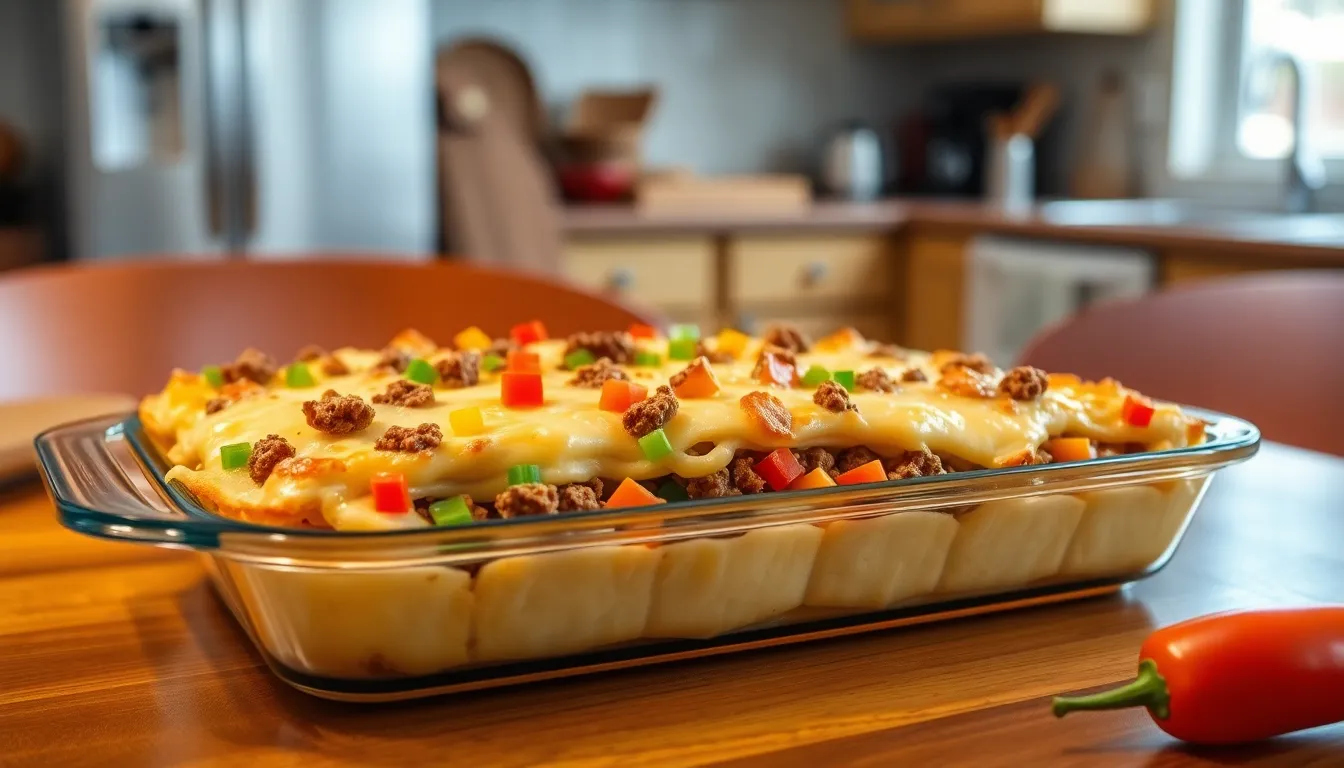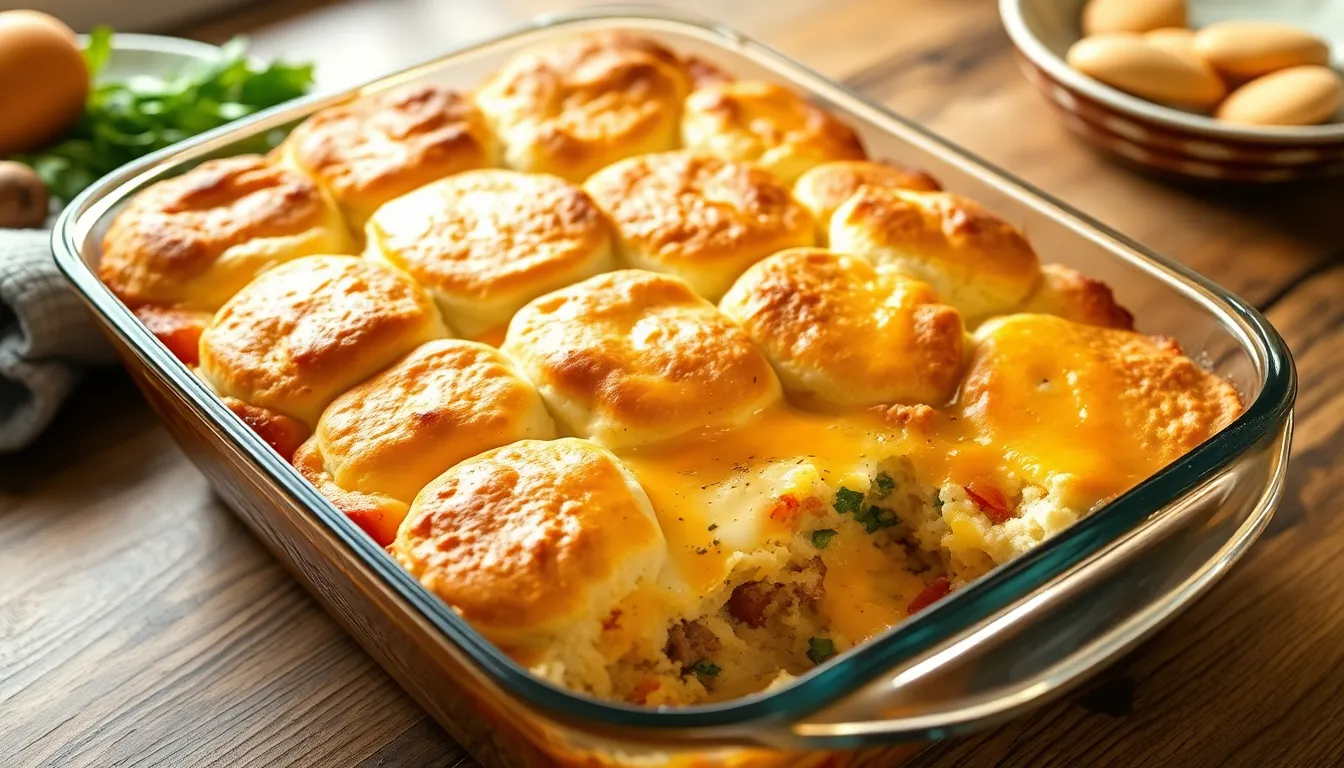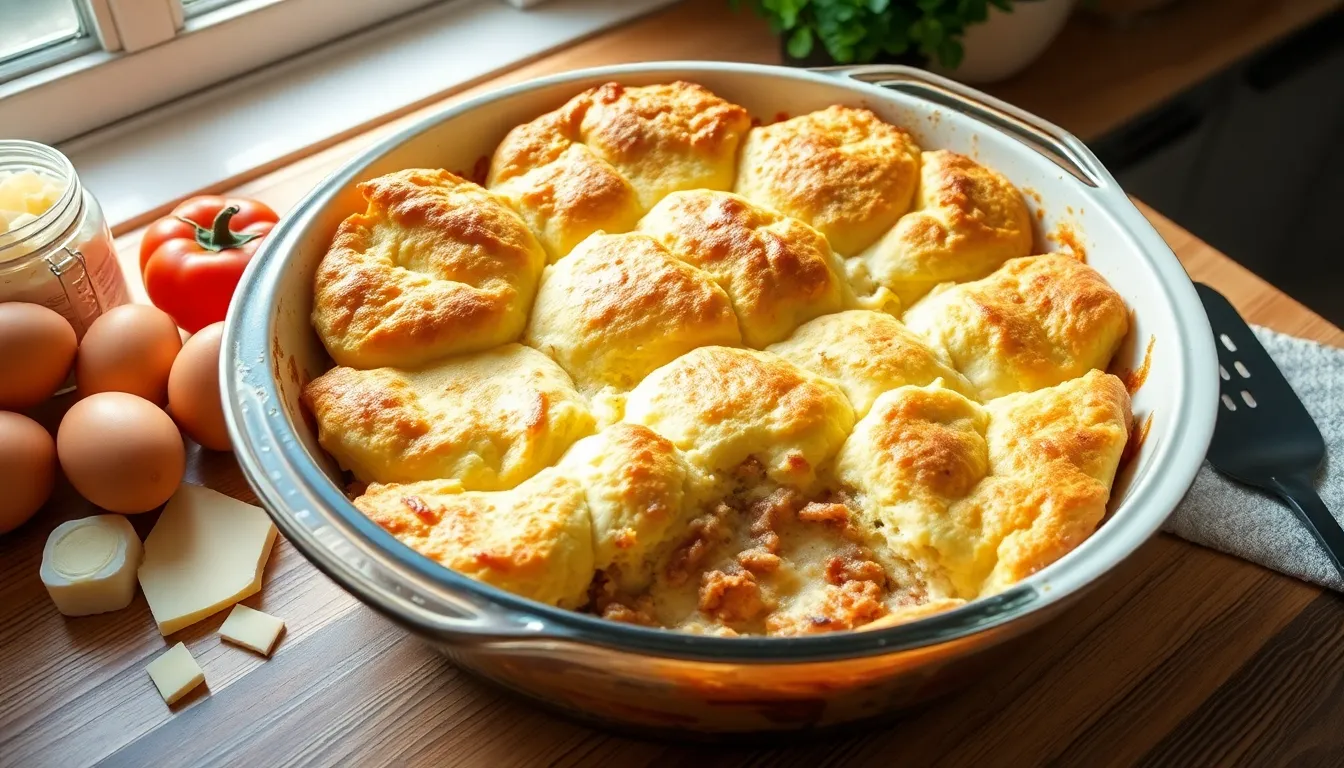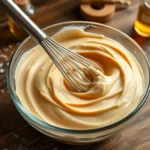We’ve discovered the ultimate breakfast game-changer that’ll transform your morning routine forever. Biscuit breakfast casserole combines all your favorite breakfast flavors into one incredible dish that’s perfect for feeding a crowd or meal prepping for busy weekdays.
This hearty casserole layers fluffy buttermilk biscuits with savory sausage, scrambled eggs, and melted cheese to create pure breakfast bliss. What makes this dish absolutely genius is how it eliminates the morning breakfast scramble – you can prep it the night before and simply pop it in the oven when you wake up.
Whether you’re hosting a weekend brunch, preparing for holiday mornings, or just want to simplify your breakfast routine, this make-ahead breakfast casserole delivers maximum flavor with minimal effort. The combination of tender biscuits soaking up rich egg custard creates an irresistible texture that’ll have everyone asking for seconds.
What You’ll Need for This Biscuit Breakfast Casserole
We’ve carefully curated this ingredient list to ensure your biscuit breakfast casserole delivers maximum flavor with minimal fuss. Our recipe calls for simple pantry staples and fresh ingredients that work together to create a hearty morning meal.
Essential Ingredients
For the Base:
- 1 package (16 oz) refrigerated buttermilk biscuits
- 1 pound breakfast sausage
- 8 large eggs
- 1/2 cup whole milk
- 2 cups shredded sharp cheddar cheese
- 1/2 cup shredded mozzarella cheese
For Enhanced Flavor:
- 1/2 teaspoon garlic powder
- 1/2 teaspoon onion powder
- 1/4 teaspoon black pepper
- 1/2 teaspoon salt
- 2 tablespoons butter
Optional Add-ins:
- 1/2 cup diced bell peppers
- 1/4 cup chopped green onions
- 1/2 cup mushrooms, sliced
Equipment You’ll Need
We recommend having these tools ready before you start cooking. A 9×13 inch baking dish serves as your primary vessel for this casserole. You’ll also need a large skillet for browning the sausage and a mixing bowl for combining the egg mixture.
Ingredient Preparation Tips
Room temperature eggs whisk more easily and create a smoother custard base for your casserole. We suggest removing them from the refrigerator 30 minutes before cooking begins. Fresh breakfast sausage provides better texture than pre-cooked varieties, though either option works well.
The buttermilk biscuits should remain refrigerated until you’re ready to cut and layer them in the dish. Sharp cheddar cheese offers the best flavor profile, while mozzarella adds that coveted cheese pull when serving.
Ingredients

We’ve organized these ingredients into three simple categories to make shopping and preparation straightforward. Each component plays a crucial role in creating the perfect balance of flavors and textures.
For the Casserole Base
- 1 (16-ounce) can refrigerated biscuits (such as Pillsbury Grand biscuits)
- 1 pound breakfast sausage
For the Egg Mixture
- 8 large eggs
- 1 to 1.25 cups milk (2% or whole)
- Salt and pepper to taste
- Optional: garlic powder and black pepper for added flavor
For Toppings and Garnish
- 1 to 1.5 cups shredded cheese (cheddar, Monterey Jack, or a combination)
- Optional: chopped herbs like parsley, diced peppers, or other vegetables
Equipment and Tools

Creating the perfect biscuit breakfast casserole requires the right equipment for optimal results. We recommend gathering these essential tools before starting your preparation to ensure a smooth cooking process.
Essential Baking Equipment
Our primary tool is a 9×13-inch baking dish, which provides the ideal size for serving 8-10 people. This rectangular dish allows even heat distribution and creates the perfect depth for layering all ingredients. Glass or ceramic dishes work exceptionally well for this casserole.
Preparation Tools
A large skillet becomes crucial for browning the breakfast sausage to perfection. We suggest using a 12-inch skillet to accommodate the full pound of sausage without overcrowding. Cast iron or stainless steel skillets deliver the best browning results.
For ingredient preparation, sharp chef knives make quick work of cutting biscuits into bite-sized pieces and dicing any vegetables you choose to add. A sturdy cutting board provides the stable surface needed for safe and efficient chopping.
Mixing and Measuring Equipment
A medium mixing bowl serves as our workspace for whisking together the egg mixture. Choose a bowl large enough to comfortably whisk 8 eggs with milk without splashing. We also recommend having measuring cups on hand for accurate milk portions.
A rotary cheese grater or box grater helps create freshly shredded cheese, which melts more evenly than pre-shredded varieties. Fresh cheese creates superior texture and flavor in the finished casserole.
Optional but Helpful Tools
A meat masher tool assists in breaking up cooked sausage into uniform crumbles. This ensures even distribution throughout the casserole. Alternatively, a wooden spoon works well for this task.
Having these tools ready streamlines the assembly process and helps create a consistently delicious breakfast casserole every time.
Prep Work and Make-Ahead Tips

Smart preparation and strategic planning transform this hearty breakfast casserole into an effortless morning meal. We’ll guide you through essential prep steps and storage methods that maximize flavor while minimizing morning stress.
Preparing Ingredients the Night Before
We recommend cooking the breakfast sausage completely and crumbling it into small pieces before assembling the casserole. This step ensures even distribution throughout the dish and eliminates any morning cooking mess. Store the cooked sausage in the refrigerator while preparing other components.
Dice bell peppers or other desired vegetables ahead of time for optimal texture and flavor integration. Fresh vegetables should be patted dry and stored in airtight containers to maintain crispness. We suggest preparing the biscuit dough by either using refrigerated biscuits or making your own from scratch.
Assembling the entire casserole the night before creates the most convenient morning experience. Layer the biscuits in your prepared baking dish and press the dough firmly to create a solid crust base. Add the cooked sausage, prepared vegetables, and cheese before pouring the whisked egg mixture over everything.
Cover the assembled casserole tightly with plastic wrap or aluminum foil and refrigerate overnight. This advance preparation allows the flavors to meld beautifully while the biscuits absorb some of the egg mixture for enhanced texture.
Storage Instructions
Proper storage maintains the casserole’s quality and extends its shelf life significantly. We store leftover casserole in airtight containers in the refrigerator for up to one week without compromising taste or texture.
Individual portion containers work exceptionally well for meal prep and convenient reheating throughout the week. Cut the cooled casserole into serving sizes and transfer to separate containers for grab-and-go breakfast options.
Freezing leftover casserole extends storage time up to three months when properly wrapped. We recommend using airtight containers or heavy-duty freezer bags to prevent freezer burn and maintain optimal flavor.
| Storage Method | Duration | Container Type |
|---|---|---|
| Refrigerated | Up to 1 week | Airtight containers |
| Frozen | Up to 3 months | Freezer-safe containers |
| Individual portions | Up to 1 week | Single-serving containers |
Thaw frozen portions in the refrigerator overnight before reheating. We suggest reheating individual servings in the microwave for 1-2 minutes or in a 350°F oven until heated through for best results.
Instructions

Now we’ll walk through each step to create our perfect biscuit breakfast casserole. These detailed instructions ensure consistent results every time.
Step 1: Prepare the Biscuit Base
Preheat your oven to 375°F and generously grease a 9×13-inch baking dish with butter or cooking spray. Remove the refrigerated biscuits from their packaging and separate each piece. Press the biscuit dough firmly into the bottom of your prepared baking dish, creating an even layer that covers the entire surface. We want to form a solid crust, so make sure to seal any gaps between the biscuit pieces by pressing the edges together with your fingers.
Step 2: Cook the Breakfast Meats
Heat a large skillet over medium-high heat and add the breakfast sausage. Cook the sausage for 8-10 minutes, breaking it apart with a wooden spoon or spatula as it browns. We need to ensure the internal temperature reaches 160°F for food safety. Once the sausage is fully cooked and crumbly, drain the excess grease and set aside to cool slightly. The meat should be golden brown and completely cooked through before assembly.
Step 3: Assemble the Casserole
Sprinkle the cooked sausage evenly over the biscuit base, distributing it to all corners of the dish. Layer the shredded cheese over the sausage, using about 1 to 1.5 cups depending on your preference for cheesiness. Add any optional ingredients like diced bell peppers or onions at this stage, sprinkling them evenly across the surface. Each layer should be distributed uniformly to ensure every bite contains all the flavors.
Step 4: Prepare the Egg Mixture
Crack 8 large eggs into a medium mixing bowl and whisk them thoroughly until the yolks and whites are completely combined. Pour in 1 to 1.25 cups of milk and continue whisking until the mixture is smooth and well blended. Season with salt, pepper, and optional garlic powder to taste. Pour this egg mixture slowly and evenly over the assembled casserole, allowing it to seep between the ingredients and cover the entire surface.
Step 5: Bake the Casserole
Place the assembled casserole in the preheated oven and bake for 35-45 minutes, or until the eggs are completely set and the biscuit top turns golden brown. We can test for doneness by inserting a knife into the center – it should come out clean when the eggs are fully cooked. The internal temperature should reach 160°F throughout. Allow the casserole to rest for 5-10 minutes before serving to let the layers settle and make cutting easier.
Serving Suggestions

Fresh fruit transforms this hearty casserole into a well-balanced breakfast spread. We recommend pairing sliced berries, melon, or citrus segments alongside each serving to add natural sweetness and vibrant color to your plate. Greek yogurt with a drizzle of honey creates another excellent complement that balances the rich, savory flavors.
Additional protein sides elevate the meal for guests with bigger appetites. Crispy bacon strips or perfectly scrambled eggs make ideal companions when you’re feeding a crowd or want to create a more substantial brunch experience. Hash browns or breakfast potatoes also pair beautifully with the casserole’s creamy texture.
Beverage pairings complete the breakfast experience perfectly. Coffee remains the classic choice, while fresh orange juice or cranberry juice add brightness to cut through the dish’s richness. Hot tea varieties like English Breakfast or Earl Grey also complement the savory elements wonderfully.
| Serving Category | Options | Purpose |
|---|---|---|
| Fresh Sides | Berries, melon, citrus, Greek yogurt | Balance richness with natural sweetness |
| Protein Additions | Crispy bacon, scrambled eggs, hash browns | Create more filling meal |
| Beverages | Coffee, orange juice, cranberry juice, tea | Complement savory flavors |
Garnish options allow you to customize each serving beautifully. Chopped fresh chives or parsley add color and mild onion flavor, while diced tomatoes provide fresh acidity. Hot sauce or salsa verde give guests the option to add heat according to their preferences.
Temperature contrast works especially well with this warm casserole. Chilled fruit salad or cold yogurt parfaits create textural interest and help cleanse the palate between bites. This combination makes every forkful more enjoyable and prevents flavor fatigue during larger portions.
Storage and Reheating Instructions

Proper storage ensures your biscuit breakfast casserole maintains its delicious flavor and texture for future meals. We’ve compiled essential guidelines to help you safely store and reheat your casserole while preserving its quality.
Refrigerator Storage
Store leftover biscuit breakfast casserole in an airtight container in the refrigerator for up to 3-4 days. We recommend covering the casserole tightly with plastic wrap or aluminum foil if keeping it in the original baking dish.
Assembled but unbaked casseroles can be stored overnight in the refrigerator covered tightly with foil. Simply bake the next morning and add a minute or two to the original baking time to ensure thorough heating.
| Storage Type | Container | Duration |
|---|---|---|
| Baked leftovers | Airtight container | 3-4 days |
| Unbaked assembled | Covered with foil | Overnight |
Freezer Storage
Assemble the casserole without baking then wrap it tightly and store in the freezer for up to 2-3 months. We suggest using heavy-duty aluminum foil or freezer-safe containers to prevent freezer burn.
Baked casserole can be frozen whole or in individual slices for up to 2 months. Portioning into single servings makes reheating more convenient for quick breakfasts throughout the week.
| Freezer Storage | Method | Duration |
|---|---|---|
| Unbaked casserole | Wrapped tightly | 2-3 months |
| Baked casserole | Whole or sliced | 2 months |
Reheating Tips
Reheat leftovers in the oven until warmed through or use the microwave for quick convenience. Oven reheating at 350°F typically takes 15-20 minutes for refrigerated portions.
Frozen casseroles should thaw overnight in the refrigerator before reheating. Bake as originally directed and add extra time as needed until heated through to an internal temperature of 165°F.
Cover the casserole with foil during part of the reheating process to prevent the top from burning while the center warms completely.
Recipe Variations and Substitutions

We believe the beauty of biscuit breakfast casserole lies in its flexibility to accommodate different tastes and dietary preferences. The basic three-layer structure remains consistent while allowing countless customization possibilities.
Meat Alternatives
Traditional breakfast sausage forms the foundation of most recipes, but we can easily swap in other proteins for varied flavor profiles. Bacon brings a smoky crispness that pairs beautifully with the fluffy biscuits and creamy eggs. Diced ham offers a milder taste that works especially well for family gatherings.
All protein options require pre-cooking before layering into the casserole. We recommend browning breakfast sausage until fully crumbly, cooking bacon until crispy, or warming pre-cooked ham until heated through. This preparation step ensures even cooking and prevents excess moisture from affecting the final texture.
Vegetarian Options
Creating a satisfying meat-free version requires omitting animal proteins while increasing vegetable content for substantial flavor and nutrition. Bell peppers add sweetness and vibrant color, while onions contribute depth and aromatic appeal. Spinach provides iron and nutrients without overwhelming the dish’s overall taste.
Mushrooms offer an earthy, umami-rich foundation that satisfies even dedicated meat eaters. We suggest using either sautéed vegetables for deeper flavors or raw vegetables for fresher textures. A veggie-packed base ensures the casserole remains filling and nutritious without relying on meat.
Cheese Variations
Shredded cheddar delivers the classic sharp flavor most people expect from breakfast casseroles. Pepper jack introduces mild heat and complexity that elevates the entire dish. Smoked gouda brings sophisticated smokiness that complements both meat and vegetable versions.
Feta cheese offers Mediterranean flair with its tangy, creamy texture that works particularly well in vegetarian preparations. We recommend selecting cheese types based on personal preferences or to complement other chosen ingredients. The cheese melts throughout the casserole, binding flavors together while creating that irresistible golden top layer.
Tips for the Perfect Biscuit Breakfast Casserole

Creating a flawless biscuit breakfast casserole requires attention to key details that transform this simple dish into a morning masterpiece. We recommend using refrigerated biscuit dough like Pillsbury Grands for optimal convenience and consistent results. Cut the biscuits into pieces rather than using them whole to ensure better distribution throughout the casserole and easier serving portions.
Temperature control plays a crucial role in achieving the perfect texture. Preheat your oven to 350°F for most recipes, though some variations may require 400°F depending on your exact ingredients. Keep your cream cheese cold when incorporating it into the recipe, as this makes cutting and mixing significantly easier.
| Temperature Guidelines | Time | Purpose |
|---|---|---|
| Oven Temperature | 350°F-400°F | Even cooking and browning |
| Baking Time | 25-30 minutes | Set eggs without overcooking |
| Resting Time | 5-10 minutes | Easier cutting and serving |
Meat preparation requires cooking sausage, bacon, or ham completely before adding it to the casserole. This prevents excess grease from pooling in your dish and ensures food safety. Brown the meat thoroughly and drain any accumulated fat to maintain the proper texture of your finished casserole.
Our egg mixture foundation determines the final custard-like consistency. Whisk eggs with milk, salt, and pepper until smooth, adding garlic powder for enhanced flavor depth. Room temperature eggs blend more easily and create a silkier texture than cold eggs straight from the refrigerator.
Cheese selection dramatically impacts both flavor and texture quality. Grate your own cheese rather than using pre-shredded varieties for superior melting characteristics and richer taste. Cheddar and Monterey Jack work exceptionally well, but pepper jack or smoked gouda can elevate the flavor profile significantly.
Assembly order matters for optimal results. Place biscuit pieces at the bottom of your greased baking dish first, followed by the cooked meat layer, then pour the egg mixture evenly over everything. Top with freshly grated cheese as the final layer before baking.
Vegetable additions require pre-cooking to prevent excess moisture from making your casserole watery. Bell peppers, mushrooms, and onions should be sautéed until tender before incorporating them into the dish. This extra step ensures your vegetables contribute flavor without compromising the casserole’s structure.
Monitor the browning process carefully during baking. Cover the casserole with foil if the top browns too quickly while the center remains unset. The casserole is perfectly done when the eggs are fully set and the top achieves a golden brown color that signals proper doneness throughout.
Conclusion
This biscuit breakfast casserole has become our go-to solution for stress-free morning meals that never disappoint. We’ve shown you how simple ingredients transform into something truly special when combined thoughtfully.
The beauty lies in its flexibility – whether you’re feeding weekend guests or meal prepping for busy weekdays this dish adapts to your needs. From make-ahead convenience to endless customization options you’ll find countless ways to make it your own.
We’re confident this recipe will earn a permanent spot in your breakfast rotation. The combination of fluffy biscuits creamy eggs and savory additions creates the perfect comfort food experience every single time.
Start with our basic version then experiment with your favorite ingredients. Your family will thank you for discovering this crowd-pleasing breakfast that brings everyone together around the table.
Frequently Asked Questions
What is a biscuit breakfast casserole?
A biscuit breakfast casserole is a hearty dish combining fluffy buttermilk biscuits, savory sausage, scrambled eggs, and melted cheese. It’s perfect for serving crowds, meal prepping, or special occasions like brunches and holidays. This all-in-one breakfast solution can be prepared ahead of time, making busy mornings hassle-free while delivering a satisfying and flavorful meal everyone will enjoy.
Can I make biscuit breakfast casserole ahead of time?
Yes, you can prepare biscuit breakfast casserole the night before. Cook and crumble the sausage, dice vegetables, and assemble the entire casserole in advance. This allows flavors to meld and biscuits to absorb the egg mixture, enhancing texture. Store the assembled unbaked casserole in the refrigerator overnight, then bake fresh in the morning for optimal results.
What ingredients do I need for biscuit breakfast casserole?
You’ll need a 16-ounce can of refrigerated biscuits, 1 pound breakfast sausage, 8 large eggs, 1-1.25 cups milk, and 1-1.5 cups shredded cheese (cheddar or Monterey Jack). Season with salt, pepper, and optional garlic powder. Optional garnishes include fresh herbs or diced vegetables. This simple ingredient list creates a delicious, crowd-pleasing breakfast dish.
How long can I store leftover biscuit breakfast casserole?
Baked casserole leftovers can be stored in airtight containers in the refrigerator for 3-4 days. For longer storage, freeze baked casseroles whole or in individual slices for up to 2 months. Unbaked assembled casseroles can be frozen for 2-3 months. Individual portioning makes reheating more convenient and helps maintain quality when storing leftovers.
What temperature should I bake biscuit breakfast casserole?
Bake biscuit breakfast casserole at 350°F-400°F until eggs are set and the top is golden brown, typically 25-35 minutes. Monitor the browning process to prevent burning while ensuring eggs are fully cooked. Let the casserole rest for 5-10 minutes before serving to ensure easy cutting and proper texture throughout the dish.
Can I make vegetarian biscuit breakfast casserole?
Yes, create a delicious vegetarian version by omitting the sausage and increasing vegetables like bell peppers, onions, spinach, and mushrooms. Pre-cook vegetables to remove excess moisture before adding to the casserole. This meat-free option maintains the same satisfying texture and flavor while accommodating vegetarian dietary preferences and providing plenty of nutritious ingredients.
What cheese works best in biscuit breakfast casserole?
Cheddar and Monterey Jack are classic choices, but you can experiment with pepper jack for heat, smoked gouda for depth, or feta for tangy flavor. Use 1-1.5 cups of freshly shredded cheese for best results, as pre-shredded cheese contains anti-caking agents that can affect melting. Fresh cheese provides better texture and more robust flavor.
How do I reheat biscuit breakfast casserole?
Reheat individual portions in the microwave for 1-2 minutes or use the oven at 350°F for 10-15 minutes. For whole casseroles, cover with foil and bake at 325°F for 15-20 minutes until heated through. Thaw frozen casseroles in the refrigerator overnight before reheating. Cover during reheating to prevent drying out while ensuring even warming.







